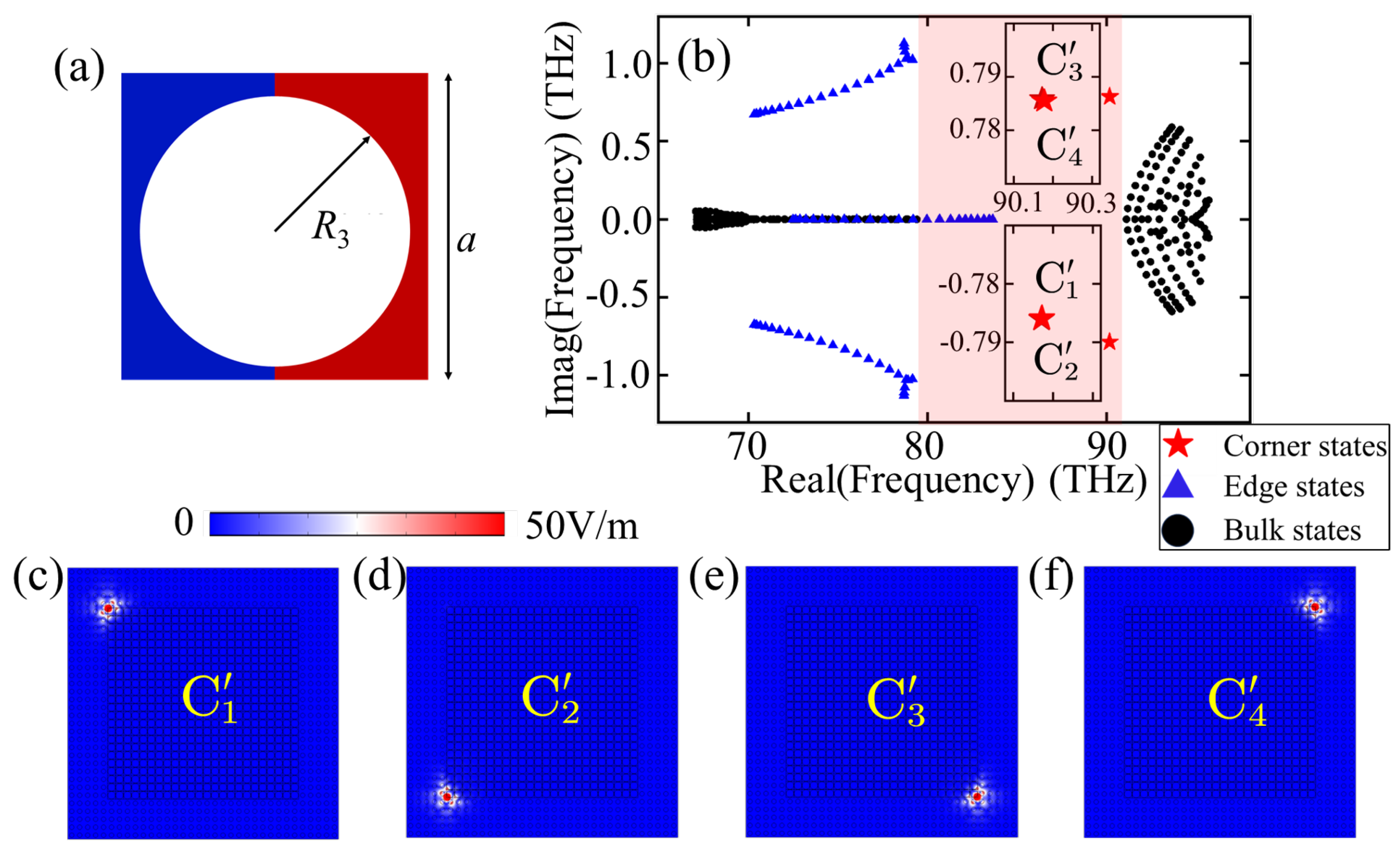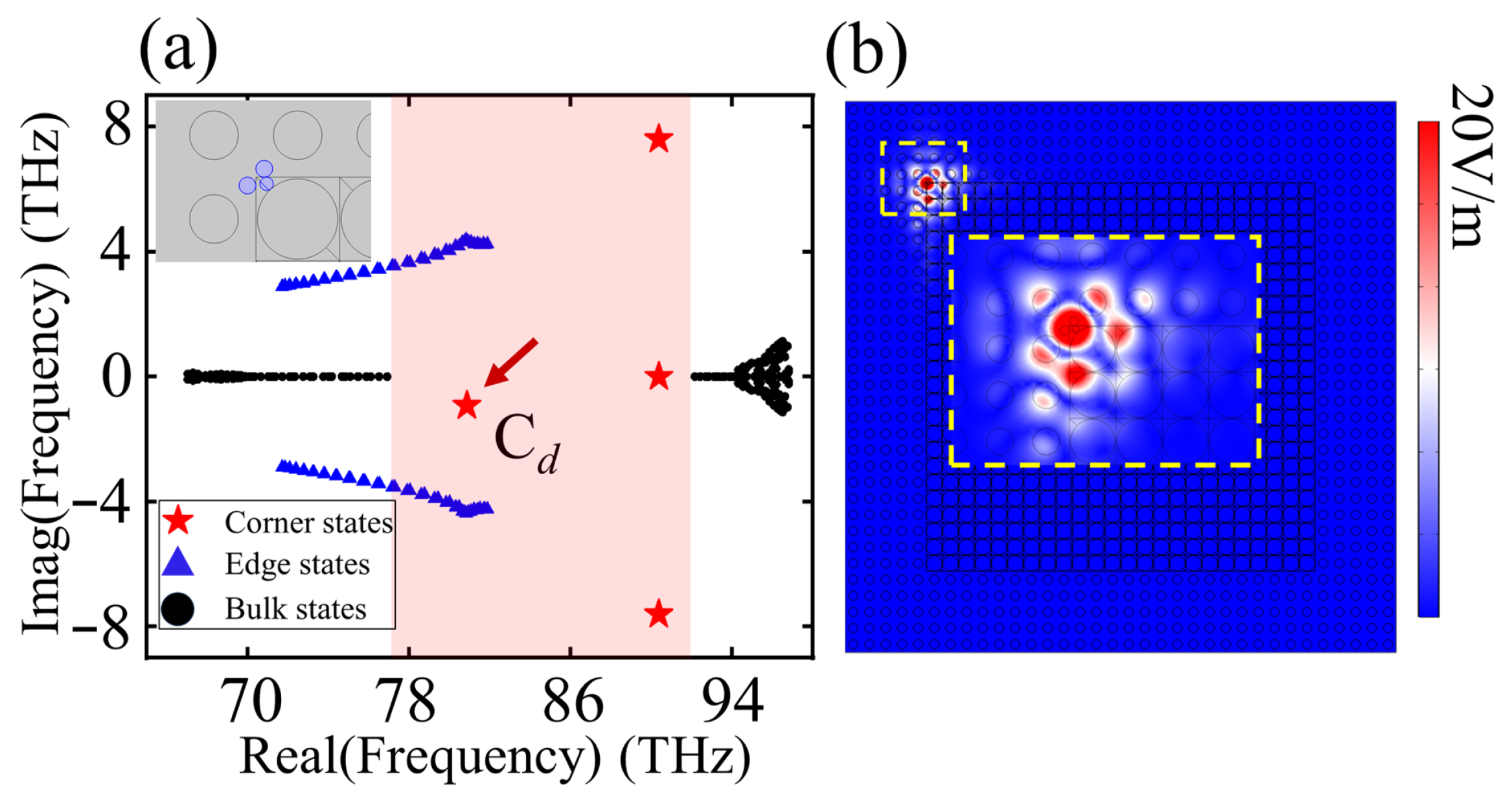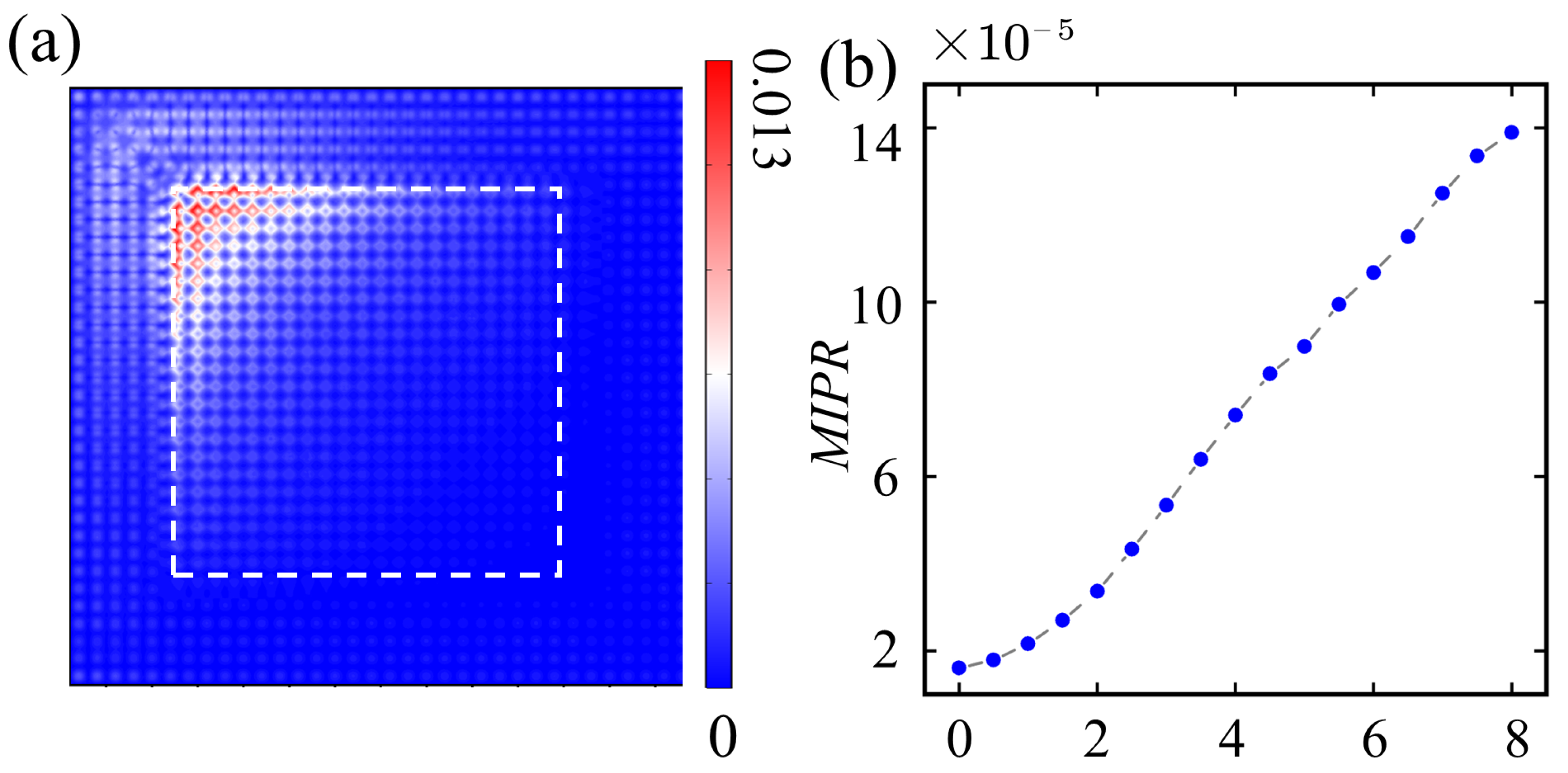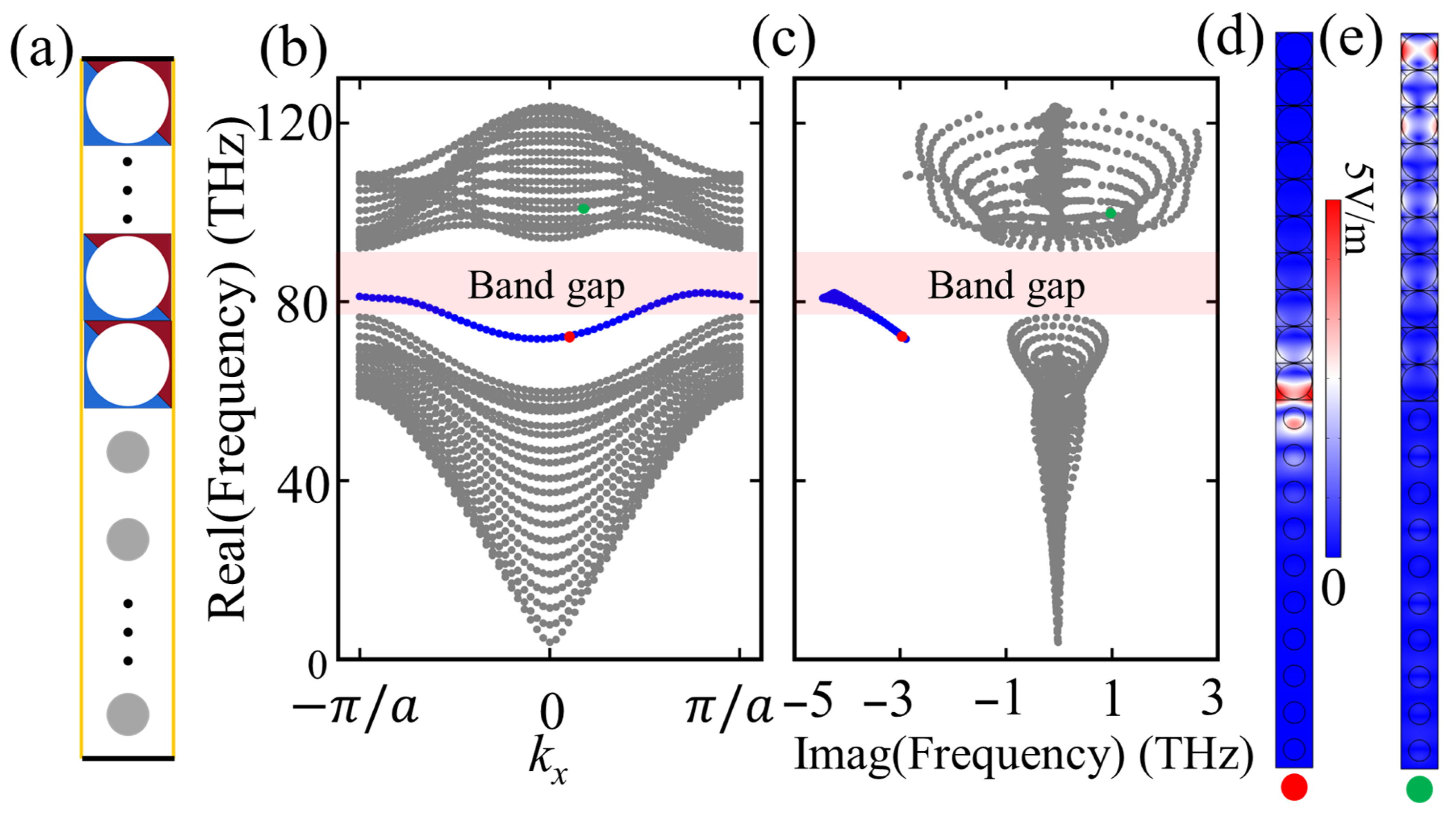Second-Order Topological States in Non-Hermitian Square Photonic Crystals
Abstract
1. Introduction
2. Non-Hermitian Square-Lattice Photonic Crystal
3. Corner States in Non-Hermitian Photonic Supercell
4. Non-Hermitian Skin Effect
5. System with PBC-OBC
6. Conclusions
Author Contributions
Funding
Institutional Review Board Statement
Informed Consent Statement
Data Availability Statement
Acknowledgments
Conflicts of Interest
Abbreviations
| PC | Photonic crystal |
| UC | Unit cell |
| NHSE | Non-Hermitian skin effect |
| PBC | Period boundary condition |
| OBC | Open boundary condition |
| MIPR | Mean inverse participation ratio |
| PEC | Perfect electric conductor |
Appendix A. Another Non-Hermitian PC

Appendix B. Introduction of Dopant Perturbations in the Supercell


Appendix C. Simulation Procedures and Details
References
- Joannopoulos, J.D.; Villeneuve, P.R.; Fan, S. Photonic crystals: Putting a new twist on light. Nature 1997, 386, 143–149. [Google Scholar] [CrossRef]
- Knight, J.C. Photonic crystal fibres. Nature 2003, 424, 847–851. [Google Scholar] [CrossRef]
- Rechtsman, M.C.; Zeuner, J.M.; Plotnik, Y.; Lumer, Y.; Podolsky, D.; Dreisow, F.; Nolte, S.; Segev, M.; Szameit, A. Photonic Floquet topological insulators. Nature 2013, 496, 196–200. [Google Scholar] [CrossRef]
- Siroki, G.; Huidobro, P.A.; Giannini, V. Topological photonics: From crystals to particles. Phys. Rev. B 2017, 96, 041408. [Google Scholar] [CrossRef]
- Midya, B.; Feng, L. Topological multiband photonic superlattices. Phys. Rev. A 2018, 98, 043838. [Google Scholar] [CrossRef]
- Ozawa, T.; Price, H.M.; Amo, A.; Goldman, N.; Hafezi, M.; Lu, L.; Rechtsman, M.C.; Schuster, D.; Simon, J.; Zilberberg, O.; et al. Topological photonics. Rev. Mod. Phys. 2019, 91, 015006. [Google Scholar] [CrossRef]
- Wang, H.; Gupta, S.K.; Xie, B.; Lu, M. Topological photonic crystals: A review. Front. Optoelectron. 2020, 13, 50–72. [Google Scholar] [CrossRef]
- Kim, M.; Jacob, Z.; Rho, J. Recent advances in 2D, 3D and higher-order topological photonics. Light Sci. Appl. 2020, 9, 130. [Google Scholar] [CrossRef] [PubMed]
- Chen, Y.; Lan, Z.; Su, Z.; Zhu, J. Inverse design of photonic and phononic topological insulators: A review. Nanophotonics 2022, 11, 4347–4362. [Google Scholar] [CrossRef]
- Jalali Mehrabad, M.; Mittal, S.; Hafezi, M. Topological photonics: Fundamental concepts, recent developments, and future directions. Phys. Rev. A 2023, 108, 040101. [Google Scholar] [CrossRef]
- Khanikaev, A.B.; Alù, A. Topological photonics: Robustness and nature. Nat. Commun. 2024, 15, 931. [Google Scholar] [CrossRef]
- Tang, G.J.; He, X.T.; Shi, F.L.; Liu, J.W.; Chen, X.D.; Dong, J.W. Topological Photonic Crystals: Physics, Designs, and Applications. Laser Photonics Rev. 2022, 16, 2100300. [Google Scholar] [CrossRef]
- Butt, M.A.; Khonina, S.N. Recent Advances in Photonic Crystal and Optical Devices. Crystals 2024, 14, 543. [Google Scholar] [CrossRef]
- Singhal, A.; Paprotny, I. Slow-Light Enhanced Liquid and Gas Sensing Using 2-D Photonic Crystal Line Waveguides—A Review. IEEE Sens. J. 2022, 22, 20126–20137. [Google Scholar] [CrossRef]
- Maleki, M.J.; Soroosh, M.; Parandin, F.; Haddadan, F. Photonic Crystal-Based Decoders: Ideas and Structures. In Recent Advances and Trends in Photonic Crystal Technology; Goyal, A.K., Kumar, A., Eds.; IntechOpen: London, UK, 2023; Chapter 5. [Google Scholar] [CrossRef]
- Starczewska, A.; Kępińska, M. Photonic Crystal Structures for Photovoltaic Applications. Materials 2024, 17, 1196. [Google Scholar] [CrossRef] [PubMed]
- Leykam, D.; Flach, S. Perspective: Photonic flatbands. APL Photonics 2018, 3, 70901. [Google Scholar] [CrossRef]
- Dong, K.; Zhang, T.; Li, J.; Wang, Q.; Yang, F.; Rho, Y.; Wang, D.; Grigoropoulos, C.P.; Wu, J.; Yao, J. Flat Bands in Magic-Angle Bilayer Photonic Crystals at Small Twists. Phys. Rev. Lett. 2021, 126, 223601. [Google Scholar] [CrossRef]
- Lu, L.; Fu, L.; Joannopoulos, J.D.; Soljačić, M. Weyl points and line nodes in gyroid photonic crystals. Nat. Photonics 2013, 7, 294–299. [Google Scholar] [CrossRef]
- Chen, W.J.; Xiao, M.; Chan, C.T. Photonic crystals possessing multiple Weyl points and the experimental observation of robust surface states. Nat. Commun. 2016, 7, 13038. [Google Scholar] [CrossRef]
- Wang, D.; Yang, B.; Gao, W.; Jia, H.; Yang, Q.; Chen, X.; Wei, M.; Liu, C.; Navarro-Cía, M.; Han, J.; et al. Photonic Weyl points due to broken time-reversal symmetry in magnetized semiconductor. Nat. Phys. 2019, 15, 1150–1155. [Google Scholar] [CrossRef]
- Pan, Y.; Cui, C.; Chen, Q.; Chen, F.; Zhang, L.; Ren, Y.; Han, N.; Li, W.; Li, X.; Yu, Z.M.; et al. Real higher-order Weyl photonic crystal. Nat. Commun. 2023, 14, 6636. [Google Scholar] [CrossRef] [PubMed]
- Wang, H.; Xu, W.; Wei, Z.; Wang, Y.; Wang, Z.; Cheng, X.; Guo, Q.; Shi, J.; Zhu, Z.; Yang, B. Twisted photonic Weyl meta-crystals and aperiodic Fermi arc scattering. Nat. Commun. 2024, 15, 2440. [Google Scholar] [CrossRef]
- Abrashuly, A.; Guo, C.; Papadakis, G.T.; Catrysse, P.B.; Fan, S. Weyl points in a twisted multilayer photonic system. Appl. Phys. Lett. 2024, 125, 171703. [Google Scholar] [CrossRef]
- Deng, W.; Lu, J.; Li, F.; Huang, X.; Yan, M.; Ma, J.; Liu, Z. Nodal rings and drumhead surface states in phononic crystals. Nat. Commun. 2019, 10, 1769. [Google Scholar] [CrossRef] [PubMed]
- Deng, W.M.; Chen, Z.M.; Li, M.Y.; Guo, C.H.; Tian, Z.T.; Sun, K.X.; Chen, X.D.; Chen, W.J.; Dong, J.W. Ideal nodal rings of one-dimensional photonic crystals in the visible region. Light Sci. Appl. 2022, 11, 134. [Google Scholar] [CrossRef]
- He, L.; Addison, Z.; Mele, E.J.; Zhen, B. Quadrupole topological photonic crystals. Nat. Commun. 2020, 11, 3119. [Google Scholar] [CrossRef]
- Proctor, M.; Huidobro, P.A.; Bradlyn, B.; de Paz, M.B.; Vergniory, M.G.; Bercioux, D.; García-Etxarri, A. Robustness of topological corner modes in photonic crystals. Phys. Rev. Res. 2020, 2, 042038. [Google Scholar] [CrossRef]
- Xie, B.; Su, G.; Wang, H.F.; Liu, F.; Hu, L.; Yu, S.Y.; Zhan, P.; Lu, M.H.; Wang, Z.; Chen, Y.F. Higher-order quantum spin Hall effect in a photonic crystal. Nat. Commun. 2020, 11, 3768. [Google Scholar] [CrossRef]
- Phan, H.T.; Liu, F.; Wakabayashi, K. Valley-dependent corner states in honeycomb photonic crystals without inversion symmetry. Opt. Express 2021, 29, 18277–18290. [Google Scholar] [CrossRef]
- Peng, Y.; Liu, E.; Yan, B.; Xie, J.; Shi, A.; Peng, P.; Li, H.; Liu, J. Higher-order topological states in two-dimensional Stampfli-Triangle photonic crystals. Opt. Lett. 2022, 47, 3011–3014. [Google Scholar] [CrossRef]
- Wang, Z.; Liu, D.; Teo, H.T.; Wang, Q.; Xue, H.; Zhang, B. Higher-order Dirac semimetal in a photonic crystal. Phys. Rev. B 2022, 105, L060101. [Google Scholar] [CrossRef]
- Wang, Y.; Wang, H.X.; Liang, L.; Zhu, W.; Fan, L.; Lin, Z.K.; Li, F.; Zhang, X.; Luan, P.G.; Poo, Y.; et al. Hybrid topological photonic crystals. Nat. Commun. 2023, 14, 4457. [Google Scholar] [CrossRef] [PubMed]
- Liu, X.Y.; Liu, Y.; Xiong, Z.; Wang, H.X.; Jiang, J.H. Higher-order topological phases in bilayer phononic crystals and topological bound states in the continuum. Phys. Rev. B 2024, 109, 205137. [Google Scholar] [CrossRef]
- Wang, Z.; Meng, Y.; Yan, B.; Zhao, D.; Yang, L.; Chen, J.; Cheng, M.; Xiao, T.; Shum, P.P.; Liu, G.G.; et al. Realization of a three-dimensional photonic higher-order topological insulator. Nat. Commun. 2025, 16, 3122. [Google Scholar] [CrossRef]
- Medina-Vázquez, J.A.; González-Ramírez, E.Y. Higher-order hybrid adiabatic topological states in photonic crystals. Phys. Rev. B 2025, 111, L020101. [Google Scholar] [CrossRef]
- Xie, B.Y.; Wang, H.F.; Wang, H.X.; Zhu, X.Y.; Jiang, J.H.; Lu, M.H.; Chen, Y.F. Second-order photonic topological insulator with corner states. Phys. Rev. B 2018, 98, 205147. [Google Scholar] [CrossRef]
- Zhou, X.; Lin, Z.K.; Lu, W.; Lai, Y.; Hou, B.; Jiang, J.H. Twisted Quadrupole Topological Photonic Crystals. Laser Photonics Rev. 2020, 14, 2000010. [Google Scholar] [CrossRef]
- Zhang, L.; Yang, Y.; Lin, Z.K.; Qin, P.; Chen, Q.; Gao, F.; Li, E.; Jiang, J.H.; Zhang, B.; Chen, H. Higher-Order Topological States in Surface-Wave Photonic Crystals. Adv. Sci. 2020, 7, 1902724. [Google Scholar] [CrossRef]
- Gong, R.; Zhang, M.; Li, H.; Lan, Z. Topological photonic crystal fibers based on second-order corner modes. Opt. Lett. 2021, 46, 3849–3852. [Google Scholar] [CrossRef]
- Jin, M.C.; Gao, Y.F.; Lin, H.Z.; He, Y.H.; Chen, M.Y. Corner states in second-order two-dimensional topological photonic crystals with reversed materials. Phys. Rev. A 2022, 106, 013510. [Google Scholar] [CrossRef]
- Chen, Y.; Lan, Z.; Zhu, J. Second-order topological phases in C 4v -symmetric photonic crystals beyond the two-dimensional Su-Schrieffer–Heeger model. Nanophotonics 2022, 11, 1345–1354. [Google Scholar] [CrossRef]
- Shao, S.; Liang, L.; Hu, J.H.; Poo, Y.; Wang, H.X. Topological edge and corner states in honeycomb-kagome photonic crystals. Opt. Express 2023, 31, 17695–17708. [Google Scholar] [CrossRef]
- Li, M.; Zhirihin, D.; Gorlach, M.; Ni, X.; Filonov, D.; Slobozhanyuk, A.; Alù, A.; Khanikaev, A.B. Higher-order topological states in photonic kagome crystals with long-range interactions. Nat. Photonics 2020, 14, 89–94. [Google Scholar] [CrossRef]
- Hawary, F.; Boisson, G.; Guillemot, C.; Guillotel, P. Compressively sampled light field reconstruction using orthogonal frequency selection and refinement. Signal Process. Image Commun. 2021, 92, 116087. [Google Scholar] [CrossRef]
- Min, L.; Sun, H.; Guo, L.; Wang, M.; Cao, F.; Zhong, J.; Li, L. Frequency-selective perovskite photodetector for anti-interference optical communications. Nat. Commun. 2024, 15, 2066. [Google Scholar] [CrossRef]
- Wang, Z.; Chong, Y.; Joannopoulos, J.D.; Soljačić, M. Observation of unidirectional backscattering-immune topological electromagnetic states. Nature 2009, 461, 772–775. [Google Scholar] [CrossRef] [PubMed]
- Kim, M.; Rho, J. Quantum Hall phase and chiral edge states simulated by a coupled dipole method. Phys. Rev. B 2020, 101, 195105. [Google Scholar] [CrossRef]
- Barczyk, R.; Kuipers, L.; Verhagen, E. Observation of Landau levels and chiral edge states in photonic crystals through pseudomagnetic fields induced by synthetic strain. Nat. Photonics 2024, 18, 574–579. [Google Scholar] [CrossRef]
- Parappurath, N.; Alpeggiani, F.; Kuipers, L.; Verhagen, E. Direct observation of topological edge states in silicon photonic crystals: Spin, dispersion, and chiral routing. Sci. Adv. 2025, 6, eaaw4137. [Google Scholar] [CrossRef]
- Xi, R.; Chen, Q.; Yan, Q.; Zhang, L.; Chen, F.; Li, Y.; Chen, H.; Yang, Y. Topological Chiral Edge States in Deep-Subwavelength Valley Photonic Metamaterials. Laser Photonics Rev. 2022, 16, 2200194. [Google Scholar] [CrossRef]
- Han, J.; Liang, F.; Zhao, Y.; Liu, J.; Wang, S.; Wang, X.; Zhao, D.; Wang, B.Z. Valley kink states and valley-polarized chiral edge states in substrate-integrated topological photonic crystals. Phys. Rev. Appl. 2024, 21, 014046. [Google Scholar] [CrossRef]
- Molesky, S.; Lin, Z.; Piggott, A.Y.; Jin, W.; Vucković, J.; Rodriguez, A.W. Inverse design in nanophotonics. Nat. Photonics 2018, 12, 659–670. [Google Scholar] [CrossRef]
- Sounas, D.L.; Alù, A. Non-reciprocal photonics based on time modulation. Nat. Photonics 2017, 11, 774–783. [Google Scholar] [CrossRef]
- Nejad, S.M.H.A.; Seyyed Fakhrabadi, M.M. Symmetry breaking and nonreciprocity in nonlinear phononic crystals: Inspiration from atomic interactions. Mech. Mater. 2025, 201, 105231. [Google Scholar] [CrossRef]
- Li, H.; Chen, Q.; Ouyang, Q.; Zhao, J. Fabricating a Novel Raman Spectroscopy-Based Aptasensor for Rapidly Sensing Salmonella typhimurium. Food Anal. Methods 2017, 10, 3032–3041. [Google Scholar] [CrossRef]
- Liu, Y.; Ouyang, Q.; Li, H.; Chen, M.; Zhang, Z.; Chen, Q. Turn-On Fluoresence Sensor for Hg2+ in Food Based on FRET between Aptamers-Functionalized Upconversion Nanoparticles and Gold Nanoparticles. J. Agric. Food Chem. 2018, 66, 6188–6195. [Google Scholar] [CrossRef] [PubMed]
- Zhang, X.; Huang, C.; Jiang, Y.; Jiang, Y.; Shen, J.; Han, E. Structure-Switching Electrochemical Aptasensor for Single-Step and Specific Detection of Trace Mercury in Dairy Products. J. Agric. Food Chem. 2018, 66, 10106–10112. [Google Scholar] [CrossRef]
- Duan, N.; Chang, B.; Zhang, H.; Wang, Z.; Wu, S. Salmonella typhimurium detection using a surface-enhanced Raman scattering-based aptasensor. Int. J. Food Microbiol. 2016, 218, 38–43. [Google Scholar] [CrossRef] [PubMed]
- Yan, T.; Zhu, H.; Sun, L.; Wang, X.; Ling, P. Investigation of an Experimental Laser Sensor-Guided Spray Control System for Greenhouse Variable-Rate Applications. Trans. ASABE 2019, 62, 899–911. [Google Scholar] [CrossRef]
- Han, F.; Huang, X.; Teye, E. Novel prediction of heavy metal residues in fish using a low-cost optical electronic tongue system based on colorimetric sensors array. J. Food Process Eng. 2019, 42, e12983. [Google Scholar] [CrossRef]
- Luo, L.; Ma, S.; Li, L.; Liu, X.; Zhang, J.; Li, X.; Liu, D.; You, T. Monitoring zearalenone in corn flour utilizing novel self-enhanced electrochemiluminescence aptasensor based on NGQDs-NH2-Ru@SiO2 luminophore. Food Chem. 2019, 292, 98–105. [Google Scholar] [CrossRef]
- Wang, P.; Li, H.; Hassan, M.M.; Guo, Z.; Zhang, Z.Z.; Chen, Q. Fabricating an Acetylcholinesterase Modulated UCNPs-Cu2+ Fluorescence Biosensor for Ultrasensitive Detection of Organophosphorus Pesticides-Diazinon in Food. J. Agric. Food Chem. 2019, 67, 4071–4079. [Google Scholar] [CrossRef]
- Xu, Y.; Zhang, W.; Shi, J.; Li, Z.; Huang, X.; Zou, X.; Tan, W.; Zhang, X.; Hu, X.; Wang, X.; et al. Impedimetric aptasensor based on highly porous gold for sensitive detection of acetamiprid in fruits and vegetables. Food Chem. 2020, 322, 126762. [Google Scholar] [CrossRef]
- Liang, N.; Hu, X.; Li, W.; Mwakosya, A.W.; Guo, Z.; Xu, Y.; Huang, X.; Li, Z.; Zhang, X.; Zou, X.; et al. Fluorescence and colorimetric dual-mode sensor for visual detection of malathion in cabbage based on carbon quantum dots and gold nanoparticles. Food Chem. 2021, 343, 128494. [Google Scholar] [CrossRef]
- Sun, Y.; Zhang, N.; Han, C.; Chen, Z.; Zhai, X.; Li, Z.; Zheng, K.; Zhu, J.; Wang, X.; Zou, X.; et al. Competitive immunosensor for sensitive and optical anti-interference detection of imidacloprid by surface-enhanced Raman scattering. Food Chem. 2021, 358, 129898. [Google Scholar] [CrossRef]
- Sharma, A.S.; Ali, S.; Sabarinathan, D.; Murugavelu, M.; Li, H.; Chen, Q. Recent progress on graphene quantum dots-based fluorescence sensors for food safety and quality assessment applications. Compr. Rev. Food Sci. Food Saf. 2021, 20, 5765–5801. [Google Scholar] [CrossRef]
- Jiang, H.; Lin, H.; Lin, J.; Yao-Say Solomon Adade, S.; Chen, Q.; Xue, Z.; Chan, C. Non-destructive detection of multi-component heavy metals in corn oil using nano-modified colorimetric sensor combined with near-infrared spectroscopy. Food Control 2022, 133, 108640. [Google Scholar] [CrossRef]
- Bi, X.; Li, L.; Luo, L.; Liu, X.; Li, J.; You, T. A ratiometric fluorescence aptasensor based on photoinduced electron transfer from CdTe QDs to WS2 NTs for the sensitive detection of zearalenone in cereal crops. Food Chem. 2022, 385, 132657. [Google Scholar] [CrossRef] [PubMed]
- Mao, H.; Du, X.; Yan, Y.; Zhang, X.; Ma, G.; Wang, Y.; Liu, Y.; Wang, B.; Yang, X.; Shi, Q. Highly sensitive detection of daminozide using terahertz metamaterial sensors. Int. J. Agric. Biol. Eng. 2022, 15, 180–188. [Google Scholar] [CrossRef]
- Liu, N.; Zhang, W.; Liu, F.; Zhang, M.; Du, C.; Sun, C.; Cao, J.; Ji, S.; Sun, H. Development of a Crop Spectral Reflectance Sensor. Agronomy 2022, 12, 2139. [Google Scholar] [CrossRef]
- Barimah, A.O.; Chen, P.; Yin, L.; El-Seedi, H.R.; Zou, X.; Guo, Z. SERS nanosensor of 3-aminobenzeneboronic acid labeled Ag for detecting total arsenic in black tea combined with chemometric algorithms. J. Food Compos. Anal. 2022, 110, 104588. [Google Scholar] [CrossRef]
- Hassan, M.M.; Xu, Y.; Zareef, M.; Li, H.; Rong, Y.; Chen, Q. Recent advances of nanomaterial-based optical sensor for the detection of benzimidazole fungicides in food: A review. Crit. Rev. Food Sci. Nutr. 2023, 63, 2851–2872. [Google Scholar] [CrossRef]
- Xu, Y.; Hassan, M.M.; Sharma, A.S.; Li, H.; Chen, Q. Recent advancement in nano-optical strategies for detection of pathogenic bacteria and their metabolites in food safety. Crit. Rev. Food Sci. Nutr. 2023, 63, 486–504. [Google Scholar] [CrossRef]
- Li, M.; Qiu, Y.; Liu, G.; Xiao, Y.; Tian, Y.; Fang, S. Plasmonic colorimetry and G-quadruplex fluorescence-based aptasensor: A dual-mode, protein-free and label-free detection for OTA. Food Chem. 2024, 448, 139115. [Google Scholar] [CrossRef] [PubMed]
- Zhang, L.; Chen, M.; Duan, H.; Bu, Q.; Dong, X. Recent advances of optical sensors for point-of-care detection of phthalic acid esters. Front. Sustain. Food Syst. 2024, 8, 1474831. [Google Scholar]
- Yao, S.; Wang, Z. Edge States and Topological Invariants of Non-Hermitian Systems. Phys. Rev. Lett. 2018, 121, 086803. [Google Scholar] [CrossRef]
- Yao, S.; Song, F.; Wang, Z. Non-Hermitian Chern Bands. Phys. Rev. Lett. 2018, 121, 136802. [Google Scholar] [CrossRef]
- Shen, H.; Zhen, B.; Fu, L. Topological Band Theory for Non-Hermitian Hamiltonians. Phys. Rev. Lett. 2018, 120, 146402. [Google Scholar] [CrossRef] [PubMed]
- Kunst, F.K.; Edvardsson, E.; Budich, J.C.; Bergholtz, E.J. Biorthogonal Bulk-Boundary Correspondence in Non-Hermitian Systems. Phys. Rev. Lett. 2018, 121, 026808. [Google Scholar] [CrossRef] [PubMed]
- Yokomizo, K.; Murakami, S. Non-Bloch Band Theory of Non-Hermitian Systems. Phys. Rev. Lett. 2019, 123, 066404. [Google Scholar] [CrossRef]
- Jin, L.; Song, Z. Bulk-boundary correspondence in a non-Hermitian system in one dimension with chiral inversion symmetry. Phys. Rev. B 2019, 99, 081103. [Google Scholar] [CrossRef]
- Yang, X.; Cao, Y.; Zhai, Y. Non-Hermitian Weyl semimetals: Non-Hermitian skin effect and non-Bloch bulk boundary correspondence. Chin. Phys. B 2022, 31, 010308. [Google Scholar] [CrossRef]
- Yang, Z.; Zhang, K.; Fang, C.; Hu, J. Non-Hermitian Bulk-Boundary Correspondence and Auxiliary Generalized Brillouin Zone Theory. Phys. Rev. Lett. 2020, 125, 226402. [Google Scholar] [CrossRef]
- Cao, Y.; Li, Y.; Yang, X. Non-Hermitian bulk-boundary correspondence in a periodically driven system. Phys. Rev. B 2021, 103, 075126. [Google Scholar] [CrossRef]
- Li, Y.; Cao, Y.; Chen, Y.; Yang, X. Universal Characteristics of One-Dimensional Non-Hermitian Superconductors. J. Phys. Condens. Matter 2023, 35, 055401. [Google Scholar] [CrossRef]
- Li, Y.; Liang, C.; Wang, C.; Lu, C.; Liu, Y.C. Gain-Loss-Induced Hybrid Skin-Topological Effect. Phys. Rev. Lett. 2022, 128, 223903. [Google Scholar] [CrossRef]
- Li, Y.; Ji, X.; Chen, Y.; Yan, X.; Yang, X. Topological energy braiding of non-Bloch bands. Phys. Rev. B 2022, 106, 195425. [Google Scholar] [CrossRef]
- Zhang, X.; Zhang, T.; Lu, M.H.; Chen, Y.F. A review on non-Hermitian skin effect. Adv. Phys. X 2022, 7, 2109431. [Google Scholar] [CrossRef]
- Ji, X.; Yang, X. Generalized Bulk-Boundary Correspondence in Periodically Driven Non-Hermitian Systems. J. Phys. Condens. Matter 2024, 36, 243001. [Google Scholar] [CrossRef] [PubMed]
- Tong, X.; Zhang, Y.; Li, B.; Yang, X. Impact of nonreciprocal hopping on localization in non-Hermitian quasiperiodic systems. Phys. Rev. B 2025, 111, 214202. [Google Scholar] [CrossRef]
- Ji, X.; Geng, H.; Akhtar, N.; Yang, X. Floquet engineering of point-gapped topological superconductors. Phys. Rev. B 2025, 111, 195419. [Google Scholar] [CrossRef]
- Shi, A.; Peng, Y.; Peng, P.; Chen, J.; Liu, J. Delocalization of higher-order topological states in higher-dimensional non-Hermitian quasicrystals. Phys. Rev. B 2024, 110, 014106. [Google Scholar] [CrossRef]
- Chen, J.; Shi, A.; Peng, Y.; Peng, P.; Liu, J. Hybrid Skin-Topological Effect Induced by Eight-Site Cells and Arbitrary Adjustment of the Localization of Topological Edge States. Chin. Phys. Lett. 2024, 41, 037103. [Google Scholar] [CrossRef]
- Ji, X.; Ding, W.; Chen, Y.; Yang, X. Non-Hermitian second-order topological superconductors. Phys. Rev. B 2024, 109, 125420. [Google Scholar] [CrossRef]
- Liang, H.Q.; Ou, Z.; Li, L.; Xu, G.F. Intrinsic perturbation induced anomalous higher-order boundary states in non-Hermitian systems. Phys. Rev. B 2025, 111, L241112. [Google Scholar] [CrossRef]
- Zhao, E.; Wang, Z.; He, C.; Poon, T.F.J.; Pak, K.K.; Liu, Y.J.; Ren, P.; Liu, X.J.; Jo, G.B. Two-dimensional non-Hermitian skin effect in an ultracold Fermi gas. Nature 2025, 637, 565–573. [Google Scholar] [CrossRef]
- Peng, Y.; Shi, A.; Peng, P.; Liu, J. Pseudospin-induced asymmetric field in non-Hermitian photonic crystals with multiple topological transitions. Phys. Rev. B 2025, 111, 085148. [Google Scholar] [CrossRef]
- Shi, A.; Bao, L.; Peng, P.; Ning, J.; Wang, Z.; Liu, J. Non-Hermitian Floquet higher-order topological states in two-dimensional quasicrystals. Phys. Rev. B 2025, 111, 094109. [Google Scholar] [CrossRef]
- Gong, Z.; Ashida, Y.; Kawabata, K.; Takasan, K.; Higashikawa, S.; Ueda, M. Topological Phases of Non-Hermitian Systems. Phys. Rev. X 2018, 8, 031079. [Google Scholar] [CrossRef]
- Liu, T.; Zhang, Y.R.; Ai, Q.; Gong, Z.; Kawabata, K.; Ueda, M.; Nori, F. Second-Order Topological Phases in Non-Hermitian Systems. Phys. Rev. Lett. 2019, 122, 076801. [Google Scholar] [CrossRef]
- Song, F.; Yao, S.; Wang, Z. Non-Hermitian Topological Invariants in Real Space. Phys. Rev. Lett. 2019, 123, 246801. [Google Scholar] [CrossRef]
- Luo, X.W.; Zhang, C. Higher-Order Topological Corner States Induced by Gain and Loss. Phys. Rev. Lett. 2019, 123, 073601. [Google Scholar] [CrossRef]
- Zeng, Q.B.; Yang, Y.B.; Xu, Y. Topological phases in non-Hermitian Aubry-André-Harper models. Phys. Rev. B 2020, 101, 020201. [Google Scholar] [CrossRef]
- Ghosh, A.K.; Nag, T. Non-Hermitian higher-order topological superconductors in two dimensions: Statics and dynamics. Phys. Rev. B 2022, 106, L140303. [Google Scholar] [CrossRef]
- Schomerus, H.; Wiersig, J. Non-Hermitian-transport effects in coupled-resonator optical waveguides. Phys. Rev. A 2014, 90, 053819. [Google Scholar] [CrossRef]
- Malzard, S.; Schomerus, H. Bulk and edge-state arcs in non-Hermitian coupled-resonator arrays. Phys. Rev. A 2018, 98, 033807. [Google Scholar] [CrossRef]
- Ao, Y.; Hu, X.; You, Y.; Lu, C.; Fu, Y.; Wang, X.; Gong, Q. Topological Phase Transition in the Non-Hermitian Coupled Resonator Array. Phys. Rev. Lett. 2020, 125, 013902. [Google Scholar] [CrossRef] [PubMed]
- Song, Y.; Liu, W.; Zheng, L.; Zhang, Y.; Wang, B.; Lu, P. Two-dimensional non-Hermitian Skin Effect in a Synthetic Photonic Lattice. Phys. Rev. Appl. 2020, 14, 064076. [Google Scholar] [CrossRef]
- Zhu, X.; Wang, H.; Gupta, S.K.; Zhang, H.; Xie, B.; Lu, M.; Chen, Y. Photonic non-Hermitian skin effect and non-Bloch bulk-boundary correspondence. Phys. Rev. Res. 2020, 2, 013280. [Google Scholar] [CrossRef]
- Feng, L.; El-Ganainy, R.; Ge, L. Non-Hermitian photonics based on parity–time symmetry. Nat. Photonics 2017, 11, 752–762. [Google Scholar] [CrossRef]
- Feng, Y.; Liu, Z.; Liu, F.; Yu, J.; Liang, S.; Li, F.; Zhang, Y.; Xiao, M.; Zhang, Z. Loss Difference Induced Localization in a Non-Hermitian Honeycomb Photonic Lattice. Phys. Rev. Lett. 2023, 131, 013802. [Google Scholar] [CrossRef]
- Lafalce, E.; Zeng, Q.; Lin, C.H.; Smith, M.J.; Malak, S.T.; Jung, J.; Yoon, Y.J.; Lin, Z.; Tsukruk, V.V.; Vardeny, Z.V. Robust lasing modes in coupled colloidal quantum dot microdisk pairs using a non-Hermitian exceptional point. Nat. Commun. 2019, 10, 561. [Google Scholar] [CrossRef]
- Król, M.; Septembre, I.; Oliwa, P.; Kȩdziora, M.; Łempicka-Mirek, K.; Muszyński, M.; Mazur, R.; Morawiak, P.; Piecek, W.; Kula, P.; et al. Annihilation of exceptional points from different Dirac valleys in a 2D photonic system. Nat. Commun. 2022, 13, 5340. [Google Scholar] [CrossRef]
- Li, A.; Wei, H.; Cotrufo, M.; Chen, W.; Mann, S.; Ni, X.; Xu, B.; Chen, J.; Wang, J.; Fan, S.; et al. Exceptional points and non-Hermitian photonics at the nanoscale. Nat. Nanotechnol. 2023, 18, 706–720. [Google Scholar] [CrossRef]
- Zhu, W.; Gong, J. Photonic corner skin modes in non-Hermitian photonic crystals. Phys. Rev. B 2023, 108, 035406. [Google Scholar] [CrossRef]
- Zheng, X.; Jalali Mehrabad, M.; Vannucci, J.; Li, K.; Dutt, A.; Hafezi, M.; Mittal, S.; Waks, E. Dynamic control of 2D non-Hermitian photonic corner skin modes in synthetic dimensions. Nat. Commun. 2024, 15, 10881. [Google Scholar] [CrossRef]
- Xiong, L.; Jiang, X.; Hu, G. Scattering singularity in topological dielectric photonic crystals. Phys. Rev. B 2024, 109, 224111. [Google Scholar] [CrossRef]
- Rybin, M.V.; Limonov, M.F. Inverse dispersion method for calculation of complex photonic band diagram and PT symmetry. Phys. Rev. B 2016, 93, 165132. [Google Scholar] [CrossRef]
- Tan, H. Measurement-Based Control of Quantum Entanglement and Steering in a Distant Magnomechanical System. Photonics 2023, 10, 1081. [Google Scholar] [CrossRef]
- Huang, F.; Chen, G.; Zhang, X. Modeling Electronic and Optical Properties of InAs/InP Quantum Dots. Photonics 2024, 11, 749. [Google Scholar] [CrossRef]




Disclaimer/Publisher’s Note: The statements, opinions and data contained in all publications are solely those of the individual author(s) and contributor(s) and not of MDPI and/or the editor(s). MDPI and/or the editor(s) disclaim responsibility for any injury to people or property resulting from any ideas, methods, instructions or products referred to in the content. |
© 2025 by the authors. Licensee MDPI, Basel, Switzerland. This article is an open access article distributed under the terms and conditions of the Creative Commons Attribution (CC BY) license (https://creativecommons.org/licenses/by/4.0/).
Share and Cite
Ding, W.; Feng, Y. Second-Order Topological States in Non-Hermitian Square Photonic Crystals. Photonics 2025, 12, 1087. https://doi.org/10.3390/photonics12111087
Ding W, Feng Y. Second-Order Topological States in Non-Hermitian Square Photonic Crystals. Photonics. 2025; 12(11):1087. https://doi.org/10.3390/photonics12111087
Chicago/Turabian StyleDing, Wenchen, and Yaru Feng. 2025. "Second-Order Topological States in Non-Hermitian Square Photonic Crystals" Photonics 12, no. 11: 1087. https://doi.org/10.3390/photonics12111087
APA StyleDing, W., & Feng, Y. (2025). Second-Order Topological States in Non-Hermitian Square Photonic Crystals. Photonics, 12(11), 1087. https://doi.org/10.3390/photonics12111087




